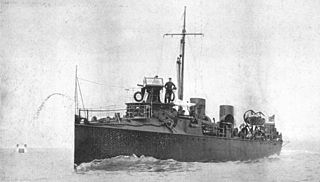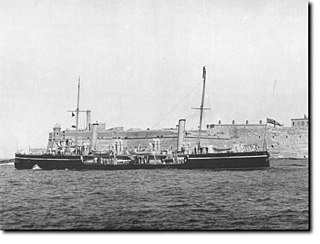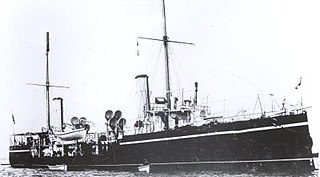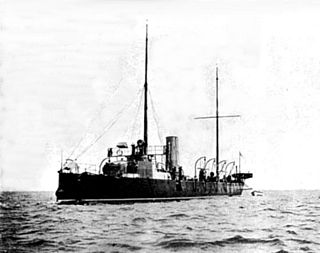
HMS Antelope was a Royal Navy Alarm-class torpedo gunboat. She was launched in 1893, reduced to harbour service from 1910 and was sold for scrapping in 1919.

HMS Hussar was a Dryad-class torpedo gunboat of the Royal Navy. She was launched in 1894 and served in the Mediterranean between 1896 and 1905 before being used for fishery protection. During the Dardanelles campaign of 1915 her commanding officer and two of her ship's company won the Victoria Cross. She was broken up in 1921.

The third HMS Halcyon was a Dryad-class torpedo gunboat of the Royal Navy. Once described as "perhaps the smallest and least formidable vessel that ever crept into the 'Navy List,' ", she was launched in 1894 and was put up for sale before World War I. She was recommissioned in 1913, was converted to a minesweeper and served under the orders of the Admiral Commanding Coast Guard and Reserves. She was sold for breaking in 1919.

In late 19th-century naval terminology, torpedo gunboats were a form of gunboat armed with torpedoes and designed for hunting and destroying smaller torpedo boats. By the end of the 1890s torpedo gunboats were superseded by their more successful contemporaries, the torpedo boat destroyers.

HMS Alresford was a Hunt-class minesweeper of the Aberdare sub-class built for the Royal Navy during World War I. She was not finished in time to participate in the First World War and survived the Second World War to be sold for scrap in 1947.
Two Swordfish-class destroyers served with the Royal Navy. Swordfish and Spitfire were both built by Armstrong Whitworth at Elswick, Tyne and Wear launching in 1895. Fitted with Yarrow boilers, they could make 27 knots and were armed with one twelve pounder and two torpedo tubes.

Three Handy-class destroyers served with the Royal Navy. Handy, Hart and Hunter were all built by Fairfield.

HMS Dryad was the name ship of the Dryad-class torpedo gunboats. She was launched at Chatham Dockyard on 22 November 1893, the first of the class to be completed. She served as a minesweeper during World War I and was broken up in 1920.

The sixth HMS Harrier was a Dryad-class torpedo gunboat. She was launched at Devonport Dockyard on 20 February 1894, and saw service in the Mediterranean and in fishery protection. She served as a minesweeper during World War I and was sold for commercial use in 1920.

The sixth HMS Hazard was a Dryad-class torpedo gunboat of the Royal Navy. She was launched in 1894 and was converted into the world's first submarine depot ship in 1901. She collided with the submarine A3 on 2 February 1912, killing 14 men, and was herself sunk in collision with SS Western Australia on 28 January 1918.

The Alarm-class torpedo gunboat was the penultimate class of torpedo gunboat built for the Royal Navy. The class was contemporary with the early torpedo boat destroyers, which were faster and thus better suited to pursuit of enemy torpedo boats. By World War I the class had either been sold, converted to submarine depot ships or minesweepers, or reduced to harbour service. Three of the class were lost during World War I while serving in the minesweeping role.

HMS Rattlesnake was a unique design of torpedo gunboat of the Royal Navy. A result of the Russian war scare of 1885, she was designed by Nathaniel Barnaby that year and built by Laird Brothers, of Birkenhead. Quickly made obsolete by the new torpedo boat destroyers, she became an experimental submarine target ship in 1906, and was sold in 1910.

The Sharpshooter-class torpedo gunboat was a class of torpedo gunboat built for the Royal Navy in the late 19th century. One of the class was hulked in 1904, seven were scrapped before World War I and five were converted to minesweepers. Of these minesweepers, Seagull was lost to a collision in 1918 and the rest survived the war to be broken up in the early 1920s.

HMS Karakatta was an Sharpshooter-class torpedo gunboat of the Royal Navy, launched in 1889. She was part of the Auxiliary Squadron of the Australia Station from 1890 until 1903, and was sold in 1905.

RHS Kanaris (L53) was a Type III Hunt-class destroyer that was originally built for the British Royal Navy as HMS Hatherleigh.

The Banterer-class gunboat was a class of eleven gunboats mounting two 6-inch and two 4-inch guns, built for the Royal Navy between 1880 and 1892.

The Albacore-class gunboat, also known as "Crimean gunboat", was a class of 98 gunboats built for the Royal Navy in 1855 and 1856 for use in the 1853-1856 Crimean War. The design of the class, by W. H. Walker, was approved on 18 April 1855. The first vessels were ordered the same day, and 48 were on order by July; a second batch, which included Surly, were ordered in early October.

The Bramble-class gunboat was a class of four gunboats mounting six 4-inch guns, built for the Royal Navy in 1886. In 1887 the first three were reclassified as gunvessels.

The Grasshopper-class torpedo gunboat was a class of torpedo gunboat built for the Royal Navy in the late 19th century. All three ships were scrapped before World War I.
HMS Alarm was a torpedo gunboat of the British Royal Navy and the name ship of her class. Alarm was built by Sheerness Dockyard from 1891–1894. She was sold for scrap in 1907.


















